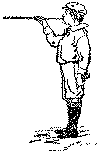By Dan Beard

Fig. 332.
The fierce cannibals of Borneo, the quaint and artistic Javanese, and the wild red men of South America all use blowguns in hunting, and even to fight with. When people depend for their dinner or personal safety upon a "putty-shooter " you may be sure that they learn to shoot with great accuracy. Some of these natives use poisoned arrows, but we must admit that even a poisoned arrow can do but little execution unless it hits the mark.

Fig. 333.
The naked youngsters of Borneo and South America acquire great skill with a blowgun, and there is no reason why bright, intelligent boys everywhere should not be able to become just as good marksmen.
The fierce head hunters of Borneo go to war armed with the same implements with which the school boys shoot peas or pellets of clay at unsuspecting citizens as they pass the ambuscade of tree or fence. The blowguns used by the Dyaks of Borneo are called sumpitans and instead of clay balls they carry poisoned arrows.
A spear is also attached to the side of one end of the sumpitan, after the manner of a bayonet on a modern rifle. In speaking of the sumpitan a recent writer says: "This curious weapon is about eight feet in length and not quite an inch in diameter, and is bored with the greatest accuracy, a task that occupies a long time, the wood being very hard and the interior of the sumpitan smooth and even polished. It is not always of the same wood. The surface is of equal thickness from end to end." Among the South American Indians the sumpitan is represented by the long delicate "pucuna" or the heavy and unwieldy "zarabatana."
Natives use poisoned arrows in their blowguns instead of harmless pellets of clay or putty. Taking a few hints from the primitive warriors and hunters of Borneo and South America, any boy, with a little care and small expense, can construct for himself a blow-gun which will be handy to carry around and will shoot with great accuracy.